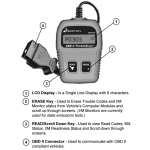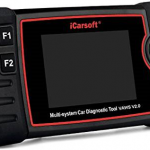Introduction to OBD2 Software for Volkswagen Skoda MQB Immobilizer Programming
Have you ever wondered how modern cars keep themselves safe from theft? Immobilizer systems are the digital guards that protect your vehicle. When it comes to Volkswagen and Skoda cars built on the MQB platform, working with these systems requires special tools and knowledge.
OBD2 software has become the go-to solution for mechanics and car enthusiasts who need to program or repair immobilizer systems. This technology lets you talk directly to your car’s computer through a simple port under your dashboard. But here’s the thing – not all OBD2 tools are created equal, especially when dealing with the complex security systems in modern VW and Skoda vehicles.
In this guide, we’ll walk through everything you need to know about using OBD2 software for MQB immobilizer programming. Whether you’re a professional mechanic or a DIY car lover, this article will help you understand the tools, processes, and best practices for working with these advanced vehicle security systems.
What is the MQB Platform and Why Immobilizer Programming Matters
The MQB platform (Modularer Querbaukasten in German) is Volkswagen Group’s smart way of building cars. Think of it as a shared foundation that multiple car brands use – kind of like how different apps can run on the same smartphone operating system.
Key Features of MQB Platform:
- Shared components across VW, Skoda, Audi, and SEAT models
- Advanced electronic systems with multiple control units
- Integrated security features including sophisticated immobilizers
- Standardized communication protocols for easier diagnosis
But why does immobilizer programming matter so much? Modern cars aren’t just mechanical machines anymore – they’re computers on wheels. The immobilizer system acts like a digital bouncer, checking that the right key is being used before allowing the engine to start.
When you need to replace a key, add a new one, or fix a faulty immobilizer, you’re essentially doing computer programming. This is where OBD2 software becomes your best friend. Without the right tools and knowledge, even simple tasks like adding a spare key can become expensive trips to the dealership.
Common Immobilizer Programming Scenarios:
- Adding new keys after losing originals
- Replacing faulty key fobs or transponders
- Fixing communication errors between key and car
- Updating immobilizer software after repairs
- Resetting systems after component replacements
Overview of OBD2 Protocols and Their Role in Immobilizer Tasks 📡
OBD2 protocols are like different languages that cars speak. Just as people from different countries need translators to communicate, different car brands use various protocols to share information between their electronic systems.
Main OBD2 Protocols Used in VW/Skoda MQB:
| Protocol | Description | Common Use |
|---|---|---|
| KWP2000 | Keyword Protocol 2000 | Older VW/Skoda models |
| UDS | Unified Diagnostic Services | Modern MQB platform vehicles |
| CAN-Bus | Controller Area Network | Real-time communication |
| TP2.0 | Transport Protocol 2.0 | Advanced diagnostic functions |
Think of these protocols as different types of phone connections. Some are like old landlines (reliable but slow), while others are like modern smartphones (fast and feature-rich). MQB platform vehicles primarily use UDS over CAN-Bus, which is like having a high-speed internet connection to your car’s brain.
How Protocols Handle Immobilizer Tasks:
The immobilizer system doesn’t work alone – it talks to multiple parts of your car. The engine control unit (ECU), body control module (BCM), and instrument cluster all need to agree that your key is legitimate. OBD2 protocols make this conversation possible by:
- Authenticating communication between diagnostic tools and car systems
- Encrypting sensitive security data during programming
- Coordinating updates across multiple control units
- Verifying that programming was successful
Compatible OBD2 Tools and Software for VW/Skoda MQB Systems 🛠️
Choosing the right OBD2 tool for MQB immobilizer work is like picking the right key for a lock – it needs to fit perfectly. Not every OBD2 scanner can handle the complex security programming that MQB systems require.
Professional-Grade Tools:
VCDS (VAG-COM Diagnostic System)
- Pros: Deep VW/Skoda integration, regular updates, excellent support
- Cons: Higher cost, requires training to use effectively
- Best for: Professional shops and serious enthusiasts
OBDeleven
- Pros: User-friendly mobile app, good for basic tasks
- Cons: Limited advanced immobilizer functions
- Best for: DIY users and simple programming tasks
Autel MaxiIM Series
- Pros: Multi-brand support, regular updates, good value
- Cons: Learning curve for VW-specific functions
- Best for: Independent shops serving multiple brands
Budget-Friendly Options:
ELM327-based Tools
- Pros: Very affordable, widely available
- Cons: Limited immobilizer capabilities, reliability issues
- Best for: Basic diagnostics only (not recommended for immobilizer work)
Clone Tools
- Pros: Low cost, often feature-rich
- Cons: Questionable reliability, potential legal issues, no support
- Best for: Not recommended for professional use
Key Features to Look For:
- MQB platform compatibility – Essential for newer VW/Skoda models
- Security gateway access – Required for immobilizer programming
- Regular software updates – Keeps up with new vehicle models
- Technical support – Crucial when you encounter problems
- User documentation – Helps you learn and troubleshoot
Evaluating Popular OBD2 Software: Features, Usability, and Cost 💰
Let’s dive deeper into the most popular OBD2 software options for MQB immobilizer programming. Each has its strengths and weaknesses, and the right choice depends on your specific needs and budget.
Detailed Software Comparison:
VCDS by Ross-Tech
- Cost: $199-399 (depending on cable type)
- Learning curve: Moderate to steep
- Immobilizer capabilities: Excellent
- Update frequency: Regular (included in price)
- Support quality: Outstanding
VCDS is like the Swiss Army knife of VW diagnostics. It can handle almost any immobilizer task you throw at it, but you’ll need to invest time in learning how to use it properly. The software documentation is excellent, but it assumes you have some technical knowledge.
OBDeleven
- Cost: $69-149 (hardware) + subscription fees
- Learning curve: Easy
- Immobilizer capabilities: Good for basic tasks
- Update frequency: Regular (subscription required)
- Support quality: Good
OBDeleven shines in user-friendliness. Its mobile app interface makes it feel like using any other smartphone app. However, advanced immobilizer programming might require the more expensive “Pro” features.
Autel MaxiIM IM608
- Cost: $2,000-3,000
- Learning curve: Moderate
- Immobilizer capabilities: Excellent
- Update frequency: Regular (subscription required)
- Support quality: Good
This is the professional’s choice. The high cost reflects its comprehensive capabilities – it’s not just an OBD2 tool but a complete key programming station.
Cost-Benefit Analysis:
| Software | Initial Cost | Yearly Cost | ROI for Professionals | DIY Value |
|---|---|---|---|---|
| VCDS | Medium | Low | High | Medium |
| OBDeleven | Low | Medium | Medium | High |
| Autel IM608 | High | High | Very High | Low |
Step-by-Step Process: Immobilizer Programming with OBD2 Software
Now let’s get to the practical stuff – how do you actually program an immobilizer using OBD2 software? The process varies depending on your specific situation, but here’s a general workflow that applies to most MQB vehicles.
Pre-Programming Preparation:
1. Gather Information
- Vehicle VIN number
- Existing key count
- Immobilizer system type
- Any fault codes present
2. Prepare Your Workspace
- Stable power supply (battery charger recommended)
- Good lighting
- Laptop with reliable OBD2 software
- Backup of original coding (crucial!)
3. Vehicle Preparation
- Engine off, ignition off
- All doors closed
- No other electronic devices active
Basic Key Addition Process:
Step 1: Connect and Identify
1. Connect OBD2 tool to diagnostic port
2. Launch software and select vehicle
3. Scan for control units
4. Identify immobilizer control unit (usually 25-Immobilizer)
Step 2: Read Current Configuration
1. Connect to immobilizer control unit
2. Read fault codes (clear if necessary)
3. Check current key count
4. Backup existing adaptation data
Step 3: Enter Programming Mode
1. Access adaptation or programming function
2. Enter security access (may require PIN)
3. Select "Add Key" function
4. Follow software prompts
Step 4: Program New Key
1. Insert new key in ignition
2. Follow timing requirements exactly
3. Wait for confirmation message
4. Test key operation
Step 5: Verify and Test
1. Check key count increased
2. Test all keys work properly
3. Clear any remaining fault codes
4. Document the work performed
Important Timing Considerations:
- Never rush the programming process
- Follow exact timing specified by software
- Don’t interrupt programming once started
- Keep ignition stable throughout process
Legal and Security Considerations in Immobilizer Coding ⚖️
Here’s something many people don’t think about – immobilizer programming isn’t just a technical challenge, it’s also a legal and ethical responsibility. When you’re working with vehicle security systems, you’re dealing with tools that could potentially be misused.
Legal Considerations:
Ownership Verification
Always verify that you have the legal right to program the vehicle. This means:
- Vehicle registration in your name or clear authorization from owner
- Proper documentation for fleet or commercial vehicles
- Business licenses if you’re providing this service professionally
Local Regulations
Different regions have different rules about who can perform immobilizer programming:
- Some areas require locksmith licenses
- Others need automotive technician certifications
- Business registration may be required for commercial services
Security Best Practices:
Protect Programming Tools
- Secure storage of OBD2 tools and software
- Regular password updates for software accounts
- Limited access to programming capabilities
- Audit trails of all programming activities
Customer Data Protection
- Secure handling of vehicle identification numbers
- Privacy protection for customer information
- Proper disposal of old keys and programming records
Ethical Responsibilities:
- Verify legitimate ownership before any work
- Refuse suspicious requests for programming services
- Report suspected theft to appropriate authorities
- Maintain professional standards in all interactions
Remember, with great power comes great responsibility. OBD2 immobilizer programming tools are powerful, and using them ethically protects both you and your customers.
Troubleshooting Common Issues During MQB Immobilizer Programming 🔍
Even with the best tools and preparation, immobilizer programming doesn’t always go smoothly. Here are the most common problems you’ll encounter and how to solve them.
Communication Errors:
Problem: “Cannot connect to immobilizer control unit”
- Check physical connections – loose OBD2 connector is the most common cause
- Verify vehicle power – low battery voltage can cause communication failures
- Try different software – some tools work better with specific vehicle years
- Check fuses – blown diagnostic fuses prevent communication
Problem: “Security access denied”
- Obtain correct PIN from vehicle documentation or dealer
- Check user permissions in software
- Verify software version supports your vehicle year
- Try alternative access methods if available
Programming Failures:
Problem: “Key programming unsuccessful”
- Check key compatibility – wrong key type for vehicle
- Verify timing – follow exact timing requirements
- Ensure stable power – use battery charger during programming
- Try programming mode reset – some systems need clearing before retry
Problem: “Adaptation values corrupted”
- Restore from backup – this is why backups are crucial
- Reset to factory defaults – last resort option
- Contact technical support – professional help may be needed
- Check for hardware faults – faulty immobilizer unit may need replacement
Post-Programming Issues:
Problem: “Key works but warning lights remain”
- Clear fault codes after successful programming
- Perform test cycle – drive vehicle to complete adaptation
- Check other systems – immobilizer connects to multiple units
- Verify complete programming – some vehicles need multiple steps
Quick Troubleshooting Checklist:
| Issue | First Check | Second Check | Last Resort |
|---|---|---|---|
| No Communication | Cable connection | Battery voltage | Different software |
| Access Denied | Correct PIN | Software version | Technical support |
| Programming Fails | Key compatibility | Stable power | Factory reset |
| Warning Lights | Clear codes | Test drive | System scan |
Tips for Safe and Successful Immobilizer Programming ✅
Success in MQB immobilizer programming comes from careful preparation and following proven best practices. Here are the tips that separate successful programmers from those who struggle.
Preparation Tips:
Always Start with Research
- Study your specific vehicle model – MQB platform has variations
- Read software documentation thoroughly before starting
- Check online forums for model-specific issues
- Have backup plans ready for common problems
Create the Right Environment
- Stable power supply – use a battery charger or power supply
- Minimize distractions – programming requires focus
- Good lighting – you need to see what you’re doing
- Organized workspace – keep tools and documentation handy
During Programming:
Follow the Process Exactly
- Don’t skip steps even if they seem unnecessary
- Respect timing requirements – rushing causes failures
- Monitor for error messages – address them immediately
- Document your progress – helps with troubleshooting
Stay Calm Under Pressure
Programming can be stressful, especially when things go wrong. Remember:
- Take breaks if you feel rushed or frustrated
- Double-check everything before proceeding
- Ask for help when you’re unsure
- Learn from mistakes – they’re valuable experience
After Programming:
Thorough Testing
- Test all functions of programmed keys
- Check for warning lights or fault codes
- Verify system operation with multiple start cycles
- Document successful procedure for future reference
Customer Communication
If you’re working for customers:
- Explain what was done in simple terms
- Provide documentation of the work performed
- Offer guidance on key care and maintenance
- Be available for follow-up questions
Long-term Success Strategies:
Continuous Learning
- Stay updated with software releases
- Join professional forums and communities
- Attend training courses when available
- Practice on your own vehicles before customer work
Build Your Reputation
- Quality work leads to referrals
- Professional attitude builds trust
- Fair pricing encourages repeat business
- Ethical practices protect your reputation
Future Trends in OBD2 Tools for Volkswagen and Skoda Vehicles 🔮
The world of automotive diagnostics is changing rapidly, and OBD2 tools for VW and Skoda vehicles are evolving along with it. Understanding these trends can help you make better tool investments and prepare for future challenges.
Emerging Technologies:
Cloud-Based Diagnostics
More OBD2 tools are connecting to the internet for:
- Real-time software updates – no more waiting for annual releases
- Remote technical support – experts can help you in real-time
- Shared diagnostic databases – learn from other technicians’ experiences
- Automated troubleshooting – AI-powered problem solving
Mobile Integration
Smartphones and tablets are becoming the primary interface:
- Wireless OBD2 adapters eliminate cable constraints
- Intuitive touch interfaces make complex tasks easier
- Augmented reality guidance – imagine seeing programming steps overlaid on your workspace
- Voice control for hands-free operation
Security Evolution:
Enhanced Encryption
As vehicle security improves, diagnostic tools must keep pace:
- Stronger authentication methods for accessing security systems
- Blockchain verification for tool and software legitimacy
- Biometric access control for high-security programming functions
- Tamper-evident logging for accountability
Manufacturer Partnerships
Tool makers are working more closely with car manufacturers:
- Official certification programs for diagnostic equipment
- Direct access to factory programming procedures
- Integrated training platforms for technician education
- Seamless warranty integration for repair documentation
Market Predictions:
Tool Consolidation
The future likely belongs to unified platforms that can:
- Handle multiple brands from a single interface
- Integrate programming and diagnostics seamlessly
- Provide predictive maintenance insights
- Connect with shop management systems automatically
Democratization of Technology
Advanced features are becoming more accessible:
- Lower cost barriers for professional-grade tools
- Simplified interfaces for non-expert users
- Educational resources built into the software
- Community-driven development of new features
Preparing for the Future:
Investment Strategies
- Choose tools with upgrade paths rather than disposable options
- Prioritize manufacturers with strong R&D investments
- Consider subscription models for always-current software
- Invest in training alongside tool purchases
Skill Development
- Learn networking basics – future tools will be connected
- Understand security principles – encryption and authentication matter
- Practice with mobile interfaces – touchscreens are the future
- Stay curious about new technologies and methods
Conclusion: Choosing the Right OBD2 Software for MQB Immobilizer Jobs 🎯
After exploring the world of OBD2 software for Volkswagen Skoda MQB immobilizer programming, what’s the bottom line? The right tool depends entirely on your specific needs, budget, and expertise level.
For Professional Mechanics:
If you’re running a shop that regularly works on VW and Skoda vehicles, VCDS or Autel MaxiIM series tools offer the best combination of capability and reliability. Yes, they require more investment upfront, but they’ll pay for themselves through increased efficiency and reduced comebacks.
For Serious Enthusiasts:
OBDeleven strikes an excellent balance between capability and ease of use. It handles most common immobilizer tasks without requiring extensive technical knowledge, and the mobile app interface feels familiar to anyone comfortable with smartphones.
For Occasional Users:
If you only need immobilizer programming occasionally, consider partnering with a professional shop rather than investing in expensive tools. The learning curve and software costs may not justify the investment for infrequent use.
Key Takeaways:
Remember the Fundamentals
- Proper preparation prevents most programming failures
- Backup everything before making changes
- Follow procedures exactly – shortcuts lead to problems
- Verify ownership and maintain ethical standards
Invest Wisely
- Choose quality over price for professional applications
- Consider total cost of ownership including updates and support
- Plan for future needs when selecting tools
- Budget for training alongside tool purchases
Stay Current
- Keep software updated for latest vehicle support
- Join professional communities for ongoing learning
- Practice regularly to maintain skills
- Embrace new technologies as they emerge
The future of automotive diagnostics is exciting, with more powerful tools becoming accessible to a broader range of users. Whether you’re troubleshooting a customer’s car or adding a spare key to your own vehicle, the right OBD2 software makes all the difference between frustration and success.
Remember, immobilizer programming is both an art and a science. The tools provide the capability, but your knowledge, patience, and attention to detail determine the outcome. Start with quality tools, invest in proper training, and always prioritize safety and ethics in your work.
Have you decided which OBD2 software is right for your MQB immobilizer programming needs? The perfect tool is out there waiting – now you have the knowledge to find it! 🚗✨





